SECTION A
Answer all questions in this section. Write the letter representing the most correct answer to each question in the box provided.
1. Which type of fruit is shown in the cross section of figure 1?
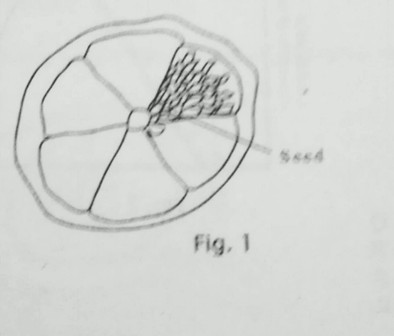
A. Berry
B. Drupe
C. Caryopsis
D. Achene
2. Which one of the following sets of bones make the axial skeleton?
A. Ribs, femur, sternum.
B. Sternum, ribs, vertebrae
C. Hind limbs, skull, limbs girdle.
D. Skull, vertebrae, humerus.
3. Which one of the following pairs of insects undergoes incomplete metamorphosis?
A. Housefly and mosquito
B. Butterfly and cockroach
C. Honey bee and moth
D. Cockroach and grasshopper.
4. Which one of the following occurs in a flower after fertilization?
A. Petals, stigma and style persist.
B. Ovary, petals and sepals dry and fall off.
C. Ovary develops into seed coat.
D. Ovules develop into seeds.
5. Figure 2. Shows the concentration of lactic acid in the blood of an athlete during and after a race. During which period on the graph does the athlete during and after a race. During which period on the graph doe the athlete not experience both aerobic and anaerobic respiration?
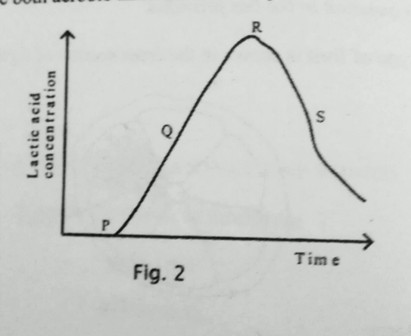
A. P-Q
B. Q- R
C. R -S
D. P - R
6. Which one of the following is not a reproductive and storage organ of a plant?
A. Yam tuber
B. Ginger rhizome
C. Cassava tuber
D. Irish potato tuber
7. Which one of the following secretions does not play a digestive role in the alimentary canal?
A. Pepsin
B. Rennin
C. Trypsin
D. Lipase
8. Which of the following are not social insects?
A. Ants
B. Bees
C. Termites
D. Butterflies
9. Which one of the following does not contribute to the efficiency of a housefly as a vector?
A. Ability to fly.
B. Feeding on liquid food.
C. Feeding in dirty places.
D. Possession of hairs on the body.
10. Figure 3. Is a transverse section through a dicotyledonous stem.
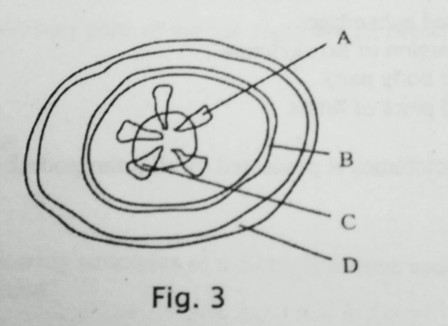
Which one of the labelled is used to transport food substances?
11. Which one of the following is the correct order in the level of organization of an organism?
A. Cells - organs - tissues - systems.
B. Tissue - organs - systems - cells
C. Cells - tissues - organs - systems
D. Organs - tissues - systems - cells
12. Which one of the following modes of reproduction is sexual?
A. Spore formation.
B. Budding
C. Fragmentation
D. Conjugation
13. Which one of the following blood vessels has the highest level of nutrients?
A. Mesenteric artery
B. Hepatic portal vein
C. Renal artery
D. Hepatic vein
14. Which one of the following farming practices does not promote soil fertility?
A. Strip cropping
B. Crop rotation
C. Monoculture
D. Mulching
15. The following are characteristics of animals
(i) Jointed appendages
(ii) Possession of exoskeleton
(iii) Three body parts.
(iv) Three pairs of limbs
Which set of characteristics is possessed by all arthropods?
A. (i) and (ii)
B. (ii) and (iii)
C. (iii) and (iv)
D. (ii) and (iv)
16. A health worker advised people to do the following:
- Wash hands before eating
- Cover all food
- Burn or bury rubbish
- Use toilets
Which one of the following disease out breaks was the health worker mainly preventing?
A. Tapeworm infection.
B. Cholera
C. Trachoma
D. Tuberculosis
17. Which one of the following organisms has the largest surface area to volume ratio?
A. Dog
B. Frog
C. Cockroach
D. Amoeba
18. In a certain plant, offspring of crosses between round- seeded and long -seeded plants were founded always to be oval -seeded.
Which one of the following results would be most likely to occur if oval seeded plants were self pollinated?
A. 100% oval -seeded.
B. 25% oval - seeded, 50% long - seeded, 25% round seeded.
C. 67% oval - seeded, 33% long -seeded
D. 25% long-seeded, 50% oval-seeded, 25% round-seeded.
19. Which one of the following parts of the ear, regulates air pressure?
A. Ear drum
B. Oval window
C. Round window
D. Eustachian tube
20. Which one of the following structures of a dicotyledonous seed is correctly matched with its function?
Structure function
A. Micropyle protection
B. Radical develops into shoot
C. Testa allows in air
D. Cotyledons store food.
21. The leaf in figure 4. Is modified for
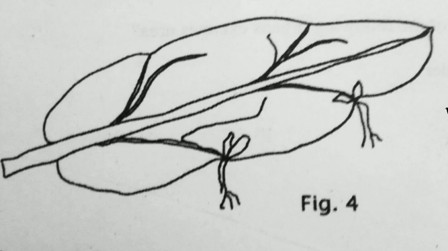
A. Absorption of nutrients
B. Reproduction
C. Photosynthesis
D. Water storage
22. Which of the following parts of a flower are essential for fertilization?
A. Filament, style and petal.
B. Petal, receptacle and sepals.
C. Ovary, anther and stigma.
D. Filament, sepal and receptacle.
23. Which one of the following enzymes acts in the duodenum and ileum?
A. Lipase
B. Maltase
C. Peptidase
D. Sucrose
24. Which one of the following is a nastic response?
A. Bending of plant shoot towards light.
B. Folding of plant leaflets when touched.
C. Growing of plant roots towards water.
D. Bending of plant root towards gravity.
25. Under activity of the thyroid gland in a child may result into
A. Overweight and sluggishness.
B. Thinness and over-activity.
C. Stunted growth and mental retardation.
D. Increased metabolic rate and restlessness.
26. Which one of the following organs excretes urea?
A. Bladder
B. Skin
C. Liver
D. Lungs
27. Which one of the following is not an adaptation of a leaf for absorption of carbon dioxide?
A. Its exposure in the air
B. Presence of airspaces in the mesophyll layer.
C. Its being thin
D. Presence of chloroplasts.
28. The hormone which causes ovulation is called
A. Follicle stimulating hormone.
B. Progesterone
C. Luteinizing hormone
D. Oestrogen
29. Which one of the following would not contribute not contribute to the accuracy of the capture -recapture method of estimating population size?
A. Using a stable population.
B. Capturing animals selectively.
C. Use of very small marks.
D. Allowing time before the recapture.
30. Which one of the following stores carbon dioxide for a long term, in the carbon cycle?
A. Living animals.
B. Dead plants.
C. Fossils.
D. Living plants.
SECTION B
Answer all questions in this section. Answers must be written in the spaces provided.
31. Table 1. Shows the body surface area and volume of two land mammals A and B. Table 2 shows the rate of metabolism in arbitrary units, of the two animals at varying environmental temperatures.
Table 1
| Mammal | Surface area (m2) | Volume (m3) |
| A | 1.2 | 0.92 |
| B | 0.6 | 0.18 |
Table 2
| Environmental Temperature (0C) | Metabolic rate (arbitrary units) | |
| Mammal A | Mammal B | |
| 16 | 10.5 | 12.9 |
| 18 | 8.9 | 10.9 |
| 20 | 7.5 | 9.2 |
| 22 | 6.4 | 7.8 |
| 24 | 5.6 | 6.7 |
| 26 | 5.0 | 5.8 |
a) From Table 1.
(i) Work out the surface area: volume ratio of each mammal.
(ii) State the structural difference between mammal A and B.
b) Using the space provided, plot on the same graph the metabolic rate of the two animals against environmental temperature.
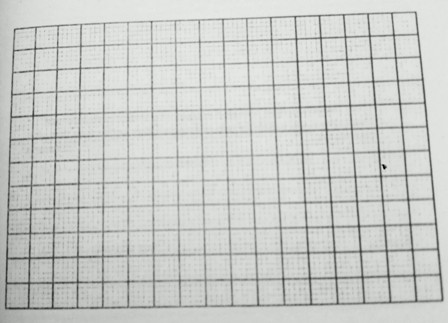
c) From your graph, determine the metabolic rate of each mammal at environmental temperature of 250c.
d) (i) How does environment temperature affect the metabolic rate of the mammals?
(ii)Explain why variation of temperature affects the metabolic rate of the mammals as stated in (c) (i).
e) From the information provided explain why at any environmental temperature, the metabolic rate of mammal B is higher than that of mammal A.
32. Withdraw of a hand from a hot object and bending of a plant shoot towards light are examples of sensitivity of living organisms.
a) What is the importance of sensitivity to living organisms?
b) State three ways in which the two actions described above differ.
c) Suggest the cause of the following defects in humans.
(i) Production of large amounts of dilute urine.
(ii) Overweight and sluggishness in an adult individual.
d) How does auxin concentration affect the growth of plant roots?
33. a) State how flowering plants obtain nitrogen from the soil.
b) How is nitrogen utilized by plants?
c) Outline the possible sources from which plants obtain nitrates.
d) Explain why water-logged soils are usually deficient in nitrates.
SECTION C
Answer any two questions.
34. a) What is meant by tropism?
b) Describe the importance of the different types of tropisms in plants.
35. a) Outline the causes of water pollution.
b) What are the effects of water pollution?
c) Suggest ways of controlling water pollution.
36. Describe how produced externally is heard by the human ear.
37. a) Outline the importance of wild life conservation.
b) What are the likely problems to be faced in wildlife conservation?
